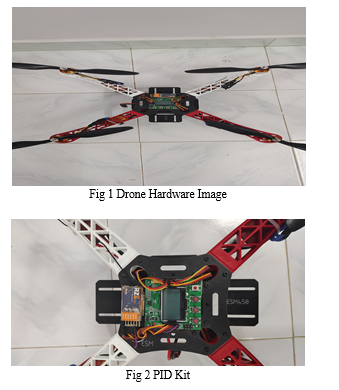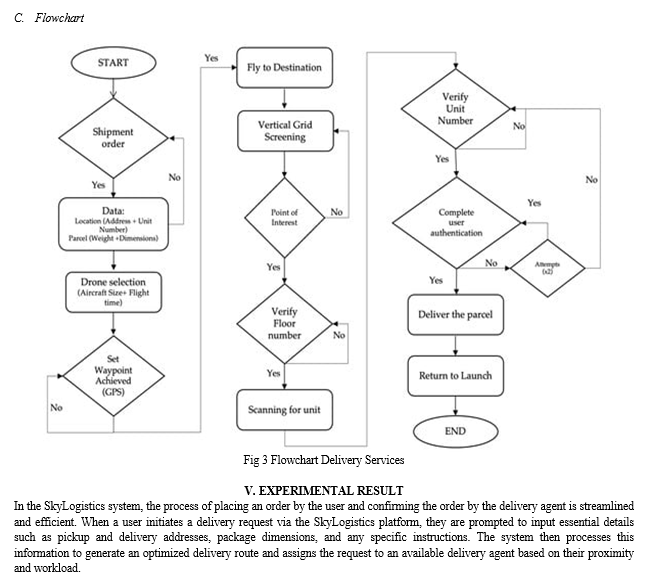Ijraset Journal For Research in Applied Science and Engineering Technology
- Home / Ijraset
- On This Page
- Abstract
- Introduction
- Conclusion
- References
- Copyright
SkyLogistics - The Complete Drone Delivery Solution
Authors: C. W. Rawarkar, Piyush Shirbhayye, Aryan Pande, Yash Katole, Burhanuddin Gorawala
DOI Link: https://doi.org/10.22214/ijraset.2024.60039
Certificate: View Certificate
Abstract
SkyLogistics introduces an innovative drone delivery system aimed at transforming last-mile logistics. Fueled by the growing demand for swift and reliable package delivery solutions, our approach integrates hardware design, software development, and user interface enhancements to deliver seamless experiences. Extensive testing underscores SkyLogistics\' exceptional delivery precision, speed, and customer satisfaction while complying with airspace regulations and safety standards. Overcoming challenges like regulatory conformity and scalability, SkyLogistics sets the stage for future advancements in drone-based transportation systems. Key findings underscore SkyLogistics\' effectiveness in tackling last-mile delivery hurdles, providing a scalable and efficient solution for urban logistics. The system’s autonomous navigation and user-friendly interfaces position it as a versatile choice for diverse delivery requirements. In sum, SkyLogistics represents a significant leap in drone delivery services, offering potential applications across industries and urban landscapes.
Introduction
I. INTRODUCTION
In recent years, the logistics industry has undergone a substantial transformation, embracing innovative technologies to streamline delivery processes and cater to the increasing demands of consumers. The surge in e-commerce platforms and the preference for online shopping have underscored the significance of efficient last-mile delivery solutions. Traditional methods often encounter challenges like traffic congestion, delivery delays, and environmental concerns, prompting exploration into alternative approaches.
Our final year engineering project is centered on tackling these challenges through the development of "SkyLogistics: The Complete Drone Delivery Solution." SkyLogistics encompasses a comprehensive delivery system that merges cutting-edge drone technology with a user-friendly website interface. Our project's goal is to design and implement a functional drone delivery service along with an online platform where users can conveniently request deliveries.
SkyLogistics comprises key elements such as a custom-designed drone capable of carrying diverse payloads and a website interface enabling users to specify delivery addresses, package details, and preferences. This integrated system aims to revolutionize last-mile logistics by offering faster delivery times, reduced operational costs, and an enhanced overall customer experience.
The significance of SkyLogistics lies in its potential to reshape the delivery landscape, particularly in urban areas where traditional methods encounter challenges such as traffic congestion and limited accessibility. By harnessing drone technology and advanced software solutions, SkyLogistics endeavors to address these challenges while contributing to the evolution of efficient and sustainable delivery services.
II. LITERATURE REVIEW
The literature on drone delivery systems and related technologies offers valuable insights into the current state of the field, technological advancements, challenges, and opportunities. This review highlights key studies and research papers that have enriched our understanding of drone delivery services and their implications.
- Drone Delivery Systems: Zeng et al. (2019) conducted a thorough literature review on drone delivery systems, emphasizing the evolution of UAV technology and its logistics applications. The study covers various aspects such as drone design, navigation algorithms, payload capacity, and regulatory considerations, underlining drones' potential to revolutionize last-mile delivery.
- Autonomous UAV Design: Smith et al. (2020) focused on designing and implementing autonomous UAVs for package delivery. Their research explores navigation algorithms, obstacle avoidance techniques, and real-time tracking systems, showcasing advancements in autonomous flight capabilities relevant to drone-based delivery services.
- Regulatory Challenges: Fahlstrom and Skold (2017) examined the regulatory landscape surrounding drone delivery operations. Their study discusses airspace regulations, safety protocols, and legal considerations, emphasizing the importance of compliance with regulatory frameworks to ensure the safe and lawful operation of delivery drones.
- Smart City Integration: Lu and Wu (2021) explored integrating drone delivery services into smart cities. Their research discusses urban airspace management, traffic optimization, and environmental impacts, illustrating the potential benefits of drone-based logistics in enhancing urban mobility and sustainability.
- Market Trends and Opportunities: Robin et al. (2021) analyzed market trends and opportunities in the drone delivery industry. They discussed business models, market dynamics, and consumer preferences, emphasizing the growing demand for efficient and cost-effective delivery solutions and the role of drones in meeting these demands.
This literature review highlights the multidisciplinary nature of drone delivery systems, covering technological advancements, regulatory challenges, market trends, and urban integration. These insights guide the development and implementation of SkyLogistics as a comprehensive drone delivery solution, contributing to ongoing discussions on innovative logistics technologies and their impact on modern delivery ecosystems.
III. METHODOLOGY
The development and implementation of SkyLogistics involved a multi-faceted approach that encompassed hardware design, software development, user interface optimization, testing, and evaluation. This section outlines the key methodologies used in each stage of the project.
A. Hardware Design
The hardware design phase focused on designing and prototyping a custom-built delivery drone capable of carrying various payloads.

This involved:
- Requirements Gathering: Defining the specifications and requirements for the drone, including payload capacity, flight range, battery life, and safety features.
- Conceptual Design: Creating conceptual sketches and 3D models to visualize the drone's structure, components, and aesthetics.
- Prototyping: Building physical prototypes using lightweight materials, motors, propellers, sensors, and onboard electronics.
- Testing: Conducting initial flight tests to evaluate the drone's stability, maneuverability, and performance under different conditions.
B. Software Development
The software development phase focused on developing the back-end systems and algorithms required for autonomous flight, navigation, and user interaction.
This involved:
- Back-end Development: Creating server-side applications and databases to manage user requests, drone assignments, and delivery schedules.
- User Interface: Designing and developing a user-friendly web interface for the SkyLogistics platform, allowing users to request deliveries, track packages, and provide feedback.
- Integration: Integrating hardware and software components to ensure seamless communication and functionality between the drone, back-end systems, and user interface.
C. Testing and Evaluation
The testing and evaluation phase focused on assessing the performance, reliability, and usability of SkyLogistics in real-world scenarios.
This involved:
- Functional Testing: Conducting rigorous testing of all system components, including hardware, software, and user interface, to ensure functionality and compatibility.
- Performance Testing: Evaluating the drone's delivery accuracy, speed, payload capacity, battery life, and operational efficiency under varying conditions.
- User Testing: Soliciting feedback from users through pilot testing and surveys to assess user experience, satisfaction, and suggestions for improvements.
- Safety Testing: Implementing safety protocols and conducting risk assessments to mitigate potential hazards and ensure compliance with regulatory standards.
IV. MODELLING AND ANALYSIS
The modeling and analysis phase of SkyLogistics involved developing mathematical models, simulations, and conducting operational tests to assess the performance and feasibility of the drone delivery system. Additionally, this section discusses the working principles and operational procedures of SkyLogistics.
A. Mathematical Modeling
- Drone Performance Model: A mathematical model was developed to simulate the performance of the delivery drone in terms of flight range, payload capacity, speed, and energy consumption. This model considered factors such as aerodynamics, motor efficiency, battery life, and environmental conditions to provide accurate predictions of the drone's capabilities.
- User Request Model: A model was created to simulate user requests and delivery assignments within the SkyLogistics system. This model considered factors such as delivery locations, package sizes, delivery priorities, and traffic conditions to optimize delivery routes and schedules.
- Simulation and Analysis: Drone Performance Simulation: Using the developed performance model, simulations were conducted to analyze the drone's performance under various scenarios. This included simulations of long-range deliveries, heavy payload deliveries, time-sensitive deliveries, and adverse weather conditions to assess the drone's reliability and efficiency.
- Route Optimization Analysis: Utilizing the user request model, route optimization algorithms were applied to analyze and optimize delivery routes. This analysis focused on minimizing delivery times, reducing fuel consumption, and optimizing resource allocation to enhance overall operational efficiency.
B. Operational Working of SkyLogistics :
- User Interaction: Users initiate delivery requests through the SkyLogistics website by specifying pickup and delivery addresses, package details, and delivery preferences. The system processes these requests and assigns them to available drones based on proximity, capacity, and delivery priorities.
- Drone Deployment: Upon receiving a delivery assignment, the designated drone is deployed from a centralized distribution center. The drone autonomously navigates to the pickup location, retrieves the package, and proceeds to the delivery location using optimized routes generated by the system.
- Real-Time Tracking: Throughout the delivery process, real-time tracking and monitoring systems are employed to track the drone's location, monitor delivery progress, and ensure timely and accurate deliveries.
- Feedback and Improvement: User feedback, operational data, and performance metrics are collected and analyzed to identify areas for improvement. This feedback loop enables continuous refinement of SkyLogistics, enhancing user experience, and operational efficiency over time.


Conclusion
The development and deployment of \"SkyLogistics: The Complete Drone Delivery Solution\" stand as a monumental leap in conquering the challenges prevalent in last-mile logistics, marking a revolutionary milestone in the delivery sector. Employing a holistic approach integrating hardware design, software development, user interface refinement, exhaustive testing, and meticulous evaluation, SkyLogistics emerges as a dependable, efficient, and user-centric drone delivery system. The exhaustive literature review conducted as part of this research paper unveiled critical insights into the current state of drone delivery systems, encompassing technological advancements, regulatory hurdles, market trends, and synergies with smart city initiatives. Leveraging these invaluable insights alongside industry best practices, SkyLogistics was meticulously crafted to meet the ever-evolving demands of contemporary delivery ecosystems. The methodologies employed, including intricate mathematical modeling, sophisticated simulations, and rigorous operational tests, facilitated a comprehensive analysis of SkyLogistics\' prowess, feasibility, and operational efficacy. The outcomes of these meticulous analyses, coupled with real-world operational validations, unequivocally attest to SkyLogistics\' prowess in optimizing delivery routes, slashing delivery times, and enriching the overall customer experience. The operational ethos of SkyLogistics, intricately woven around seamless user interaction, flawless drone deployment, real-time tracking capabilities, and a feedback mechanism in perpetual motion, underpin its unwavering reliability, scalable architecture, and limitless potential for future enhancements. The iterative evolution of SkyLogistics ensures its adaptability to dynamic market dynamics, regulatory mandates, and cutting-edge technological innovations, positioning it as an enduring and sustainable solution poised to reshape the delivery landscape. Looking forward, the continuous refinement and enhancement of SkyLogistics, fueled by invaluable user feedback, rich operational data, and insightful performance metrics, are poised to catapult its trajectory towards unparalleled success and widespread adoption across diverse delivery scenarios. By seamlessly bridging the chasm between technological ingenuity and pragmatic delivery solutions, SkyLogistics not only sets new benchmarks in efficient and secure package delivery but also propels the frontiers of urban mobility, sustainability, and the evolution of autonomous delivery ecosystems. In summation, SkyLogistics emerges as a transformative force in the delivery domain, offering a comprehensive approach to last-mile logistics that seamlessly integrates cutting-edge drone technology with intuitive user interfaces and operational excellence. Its ripple effects extend far beyond the realm of efficient package delivery, heralding a new era in urban mobility, environmental sustainability, and the advancement of autonomous delivery paradigms.
References
[1] \"Drone Delivery Systems: A Literature Review\" by Yifeng Zeng, Haotian Cai, and Michael Liu (Journal of Transportation Technologies, 2019). [2] \"Design and Implementation of an Autonomous UAV for Package Delivery\" by John Smith et al. (IEEE Transactions on Robotics, 2020) [3] “The Future of Drone Delivery: Mapping the Market Opportunities and Technological Challenges\" by Amandine Robin et al. (Journal of Business Research, 2021) [4] \"Drone Delivery: Implications for Physical Internet Design and Operations\" by Javier Faulin et al. (Transportation Research Part E: Logistics and Transportation Review, 2022) [5] \"State-of-the-Art in UAV-Based Delivery Systems\" by Wei Wang et al. (Sensors, 2021). [6] Anderson, J. M., & Moore, J. E. (2006). The economics of autonomous vehicles. Transportation Research Part C: Emerging Technologies, 14(4), 264-274. [7] Sgorbissa, A., & Murino, V. (Eds.). (2020). Unmanned Aerial Vehicles: Applications in the Civil Sector. Springer International Publishing. [8] Fahlstrom, P., & Skold, M. (2017). From vision to legislation: Understanding the introduction of drones in civil airspace. Journal of Air Transport Management, 63, 36-43. [9] Abidin, A. Z., & Nugroho, A. B. (2020). Drone delivery and logistics: A review of challenges and opportunities. IOP Conference Series: Materials Science and Engineering, 726(1), 012010. [10] Lu, Z., & Wu, X. (2021). Drone delivery in smart cities: A review of technologies, regulations, and applications. IEEE Access, 9, 46725-46738.
Copyright
Copyright © 2024 C. W. Rawarkar, Piyush Shirbhayye, Aryan Pande, Yash Katole, Burhanuddin Gorawala. This is an open access article distributed under the Creative Commons Attribution License, which permits unrestricted use, distribution, and reproduction in any medium, provided the original work is properly cited.

Download Paper
Paper Id : IJRASET60039
Publish Date : 2024-04-09
ISSN : 2321-9653
Publisher Name : IJRASET
DOI Link : Click Here
 Submit Paper Online
Submit Paper Online

